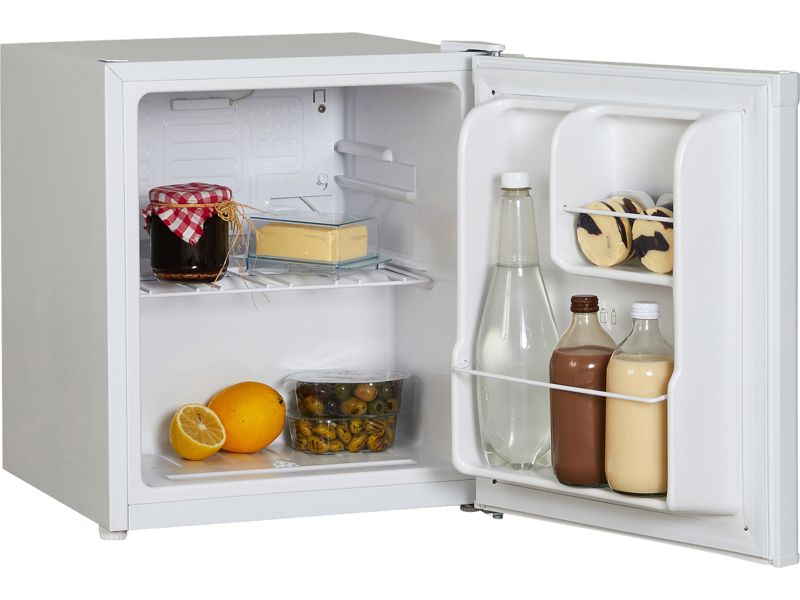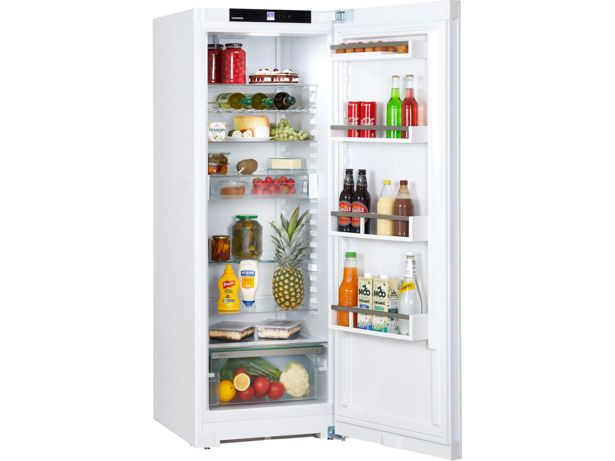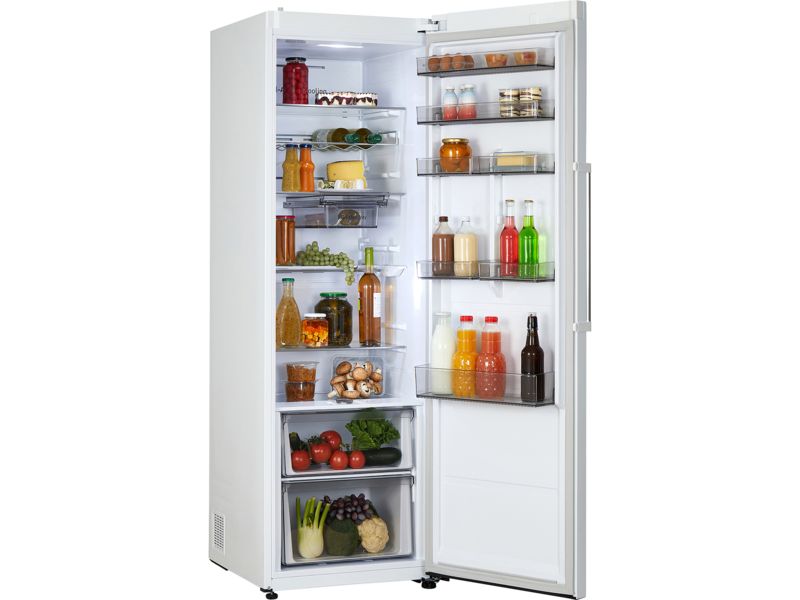How we test fridges

To help you buy the perfect fridge, we review the temperature accuracy and energy efficiency of every model in our lab. Here, we explain how we carry out those expert tests.
Many free-to-access websites that publish reviews receive appliances straight from the manufacturer. At Which? we buy the fridges that we plan on testing – that means you can be sure our verdicts are genuine. Our overall percentage score is calculated purely on measurements and ratings supplied by our lab.
Below, we explain our star rating system, which helps us identify the fridges genuinely worth your money. Plus, we cover how our labs study cooling speed and energy use.
Not yet a member? Join Which? and gain instant access to all our reviews.
What are Which? Best Buy, Great Value, Eco Buy and Don't Buy fridges?

We give Best Buys to fridges that impress the most in our tests. Fridges that score 75% or more are Best Buys and come with a firm overall recommendation, although you should still read our reviews to check for any factors that might impact your buying decision. Meanwhile, fridges that score 45% or below are Don’t Buy models to avoid.
Best Buy fridges
Best Buy fridges typically tick the most important boxes. They're quick to cool down, stick closely to their set temperature and don't use too much energy.
Great Value fridges
How much buyers are willing to spend on a fridge varies, so that’s where our Great Value recommendation comes in.
These models do pretty well in our tests – scoring 65% or more – and they still score four stars or better for chilling power and energy efficiency. In other words, they keep your food safely chilled but cost less to run compared to lower-scoring models. They're also at least 20% cheaper than the average price for that type of product in our tests.
Great Value models are the ones to go for if you’re looking for a bargain. Some of these will also score well enough to be Best Buys.
Eco Buy fridges
If you want to make the most sustainable choice when you next buy a fridge, go for an Eco Buy model.
Eco Buy fridges will have a lower impact on the environment over their lifetimes than other models.
We calculate this in two ways: how reliable and therefore long-lasting it's likely to be – so you don't have to repair or replace it as often – and how energy efficient it is.
To become an Eco Buy, a fridge must have:
- a total test score of at least 70%
- five stars for energy efficiency
- four stars and above for cooling power
- not come from a brand that gets a poor longevity rating in our annual consumer surveys.
Only between 5% and 10% of fridges are sustainable enough to be Eco Buys. To find out which models qualify, head to our fridge reviews and use the Eco Buy filter.
Don't Buy fridges
Don't Buy fridges fall down in important areas. They might take ages to cool down and then veer away from the temperature they're set at.
How the Which? score is calculated
The Which? overall test score is a percentage. This score only takes into account the results of our tests and ignores price completely.
This means that all fridges are tested on exactly the same scale, so you can compare any model at any price and know how it measures up against its rivals in key areas.
Weightings and star ratings
A Which? overall score is made up of dozens of individual tests and checks, from key factors such as speed of cooling, temperature accuracy and energy usage, to ease of use and cleaning.
To keep things simple, the most important scores are shown as star ratings out of five on each fridge’s Test Results section as an easy-to-compare list of strengths and weaknesses, so you can quickly work out whether it's right for you.
The most important test results have a greater impact on a fridge's overall score:
- cooling – 35%
- energy efficiency – 22%
- convenience, including ease of use, ease of cleaning and noise – 12%
- accuracy of recommended thermostat setting – 10%
- performance at the optimum setting – 10%
- ability to keep contents chilled in a hot room – 6%
- effectiveness of the vegetable compartment – 5%.
Our key testing criteria
See below for our key testing categories and how we evaluate each one.

Cooling
Key question: how well will the fridge chill my food?
The faster your groceries chill, the longer they'll last and the more nutrients they will retain.
Our tough tests challenge fridges to see what they'll be like when you use them at home.
We set the room temperature to 23°C and part-fill the compartments with gel packs to simulate food already stored inside. When those have cooled, we add even more gel packs to the fridge – roughly equivalent in size to what you'd buy when you do a top-up shop for fresh food – and record the time taken for the packs to cool.
The best fridges chill in a matter of hours, whereas the worst struggle to complete our tests during two days of testing.
Cooling makes up 35% of a fridge's score.
Energy efficiency
Key question: how much will the fridge add to my energy bills?
Because your fridge is always switched on, you'll constantly pay to power it. It should never be switched off, though, as you risk getting food poisoning and incurring higher bills as the appliance uses energy to try and lower the temperature again. Our expert tests help you buy a fridge that's energy efficient for its size.
In 2023, we updated our energy tests to make them even more stringent. The results of fridges published before and after September 2023 are not 100% comparable, but our scores covering older models still give a very good indication of how a fridge will perform in your kitchen.
Several tests go into our new energy measurements covering fridges, including:
- How much energy each fridge uses to keep food cool, measured over a 24-hour period. During this time, we open and close the fridge door multiple times to replicate how you'd use it in real life: opening it a few times a day to take food out and/or put new shopping in.
- How much energy each fridge uses to chill fresh food.
Once these checks are finished, we calculate what this is likely to add to your energy bill. To see whether a fridge is cheap to run for its size, we also rate its energy use against the amount of useable storage space it offers – you can see the results on the technical specification tab for each fridge review.
Energy efficiency makes up 22% of a fridge's score.
Convenience
Ease of use and cleaning
Key question: how easy is it to use and clean the fridge?
Some fridges are easier to use than others, and an irritating niggle can quickly become a major frustration if you experience it several times a day. So we rate ease of use, paying close attention to how sturdy the shelves and drawers are, how smoothly the drawers slide in and out, and whether you can fit a two-litre bottle of water in the door rack.
We spray cherry juice inside each fridge and let it dry to a sticky mess. Then, we rate how easy it is to clean and see how likely food and drink spills are to seep into hard-to-reach spots and crevices. The best fridges are easy to keep clean, while the worst have dirt traps that can harbour food spills and bacteria.
Quietness
Key question: how noisy will the fridge be in my kitchen?
The answer to this question is particularly important if you're working or studying from home in a kitchen, or living in a studio flat.
Every fridge that makes its way to our test lab is assessed for noise in specially designed sound chambers. It's possible for a fridge to be quiet for long stretches, and then make clunking sounds when the compressor activates, so we assess sound quality over a prolonged period, rather than just taking a one-off decibel measurement.
Convenience contributes 12% to the total test score.
Accuracy of thermostat
Key question: can you trust the fridge thermostat?
When you’re setting up your fridge in your kitchen for the first time, most instruction manuals will recommend a thermostat setting. But unless you check with a thermometer, it can be hard to tell whether the recommended setting is reaching the ideal temperature.
Our experts test how accurate the thermostat in the fridge is. We set the appliance to the manufacturer-recommended setting, then see if doing so brings it down to the temperature being aimed for.
We test this by following the brand's own instructions to set the thermostat and then recording the temperature of gel packs in the fridge.
The best fridges will chill to perfect temperatures as soon as you’ve set them up. But the worst are way off, leaving food too warm. This might make your food go off more quickly than it should, so you’d need to use a fridge thermometer to get the running temperature right.
The accuracy of the recommended thermostat setting accounts for 10% of the total test score.
Performance on the optimum setting
Key question: how well does a fridge perform when it's set to the optimum setting?
Not all fridges reach the temperatures promised by their thermostat. We set the appliance to the optimum or ideal setting – that means programming it to be at 4°C, and then testing its ability to cool food under those conditions. If we can't set the fridge to be 4°C exactly because of the dials or other controls available on the panel, we set it as near to this as we can get it, opting for slightly lower if needed rather than higher.
Performance on the optimum setting accounts for 10% of the total test score.
Ability to keep contents chilled in a hot room
Key question: will the fridge keep my food safely chilled in a hot environment?
Your fridge needs to keep food chilled around the clock, even when your kitchen heats up and cools down. An evenly cool environment is essential for preventing harmful bacteria from growing and stopping food from spoiling faster than necessary.
With that in mind, we raise the temperature in our test chamber to 35°C, replicating a heat wave, to see whether the gel packs inside the fridge remain safely chilled.
Temperature stability in warm rooms makes up for 6% of the score for a fridge.
Effectiveness of the vegetable compartment
Key question: will my fridge vegetable drawer keep vegetables fresh?
We test vegetable preservation by checking weight loss and temperature. If your fridge drawer has a slider for controlling humidity, we check its effectiveness.
Our lab experts also monitor the temperature of the drawer, which should be should be between 0 and 4°C . If the temperature goes below 0°C – at which point your vegetables would go icy and be ruined – we penalise the drawer even more.
Some vegetables prefer dryer conditions to others and so this particular test only assesses suitability for fruit and vegetables that like cold, humid conditions. Asparagus, blueberries and broccoli, for example.
Effectiveness of the vegetable drawer contributes 5% to the score for a fridge.
Which? refrigeration testing changes
We constantly improve our fridge tests to ensure only the very best models are Best Buys. This means that newer models have been tested and rated in a slightly different way to older models, but you can still use the overall test scores to compare one fridge with another.
Our testing program has been updated several times over the years. You can see when each fridge was tested under the ‘Technical specification’ tab in each review.
- Fridges tested before 2015 – Convenience and cleaning tests were based on visual assessments and an inventory of features.
- Fridges tested between 2015 and 2018 – Our new convenience test assesses how easy the storage features are to use and access, how loud and accurate the alarms are, how good the lighting is inside and how easy models are to program.
- Fridges tested from 2018 onwards – Ease-of-use tests now include a measure for how much force is required to open the fridge door 10 seconds after it has been closed. If a lot of force is needed we draw this out in the review. We've also improved our noise assessment as well as placing even more emphasis on how well a fridge performs its essential task of chilling
- Fridges tested from September 2023 onwards – Due to the cost of living and climate crisis, we made our energy testing harsher and even more closely representative of ordinary consumer use, and increased the emphasis we place on energy in our evaluation.
Fridge running costs
In light of rising energy costs, we now take into account the amount of power a fridge uses to chill fresh food to give you a more accurate idea of how each model might impact on your energy bills.
Because our energy calculations are now more accurate, running costs for models tested before and after 2015 shouldn’t be directly compared.
Make sure you avoid a dud and choose a fridge that excels in our tests with our fridge reviews.


